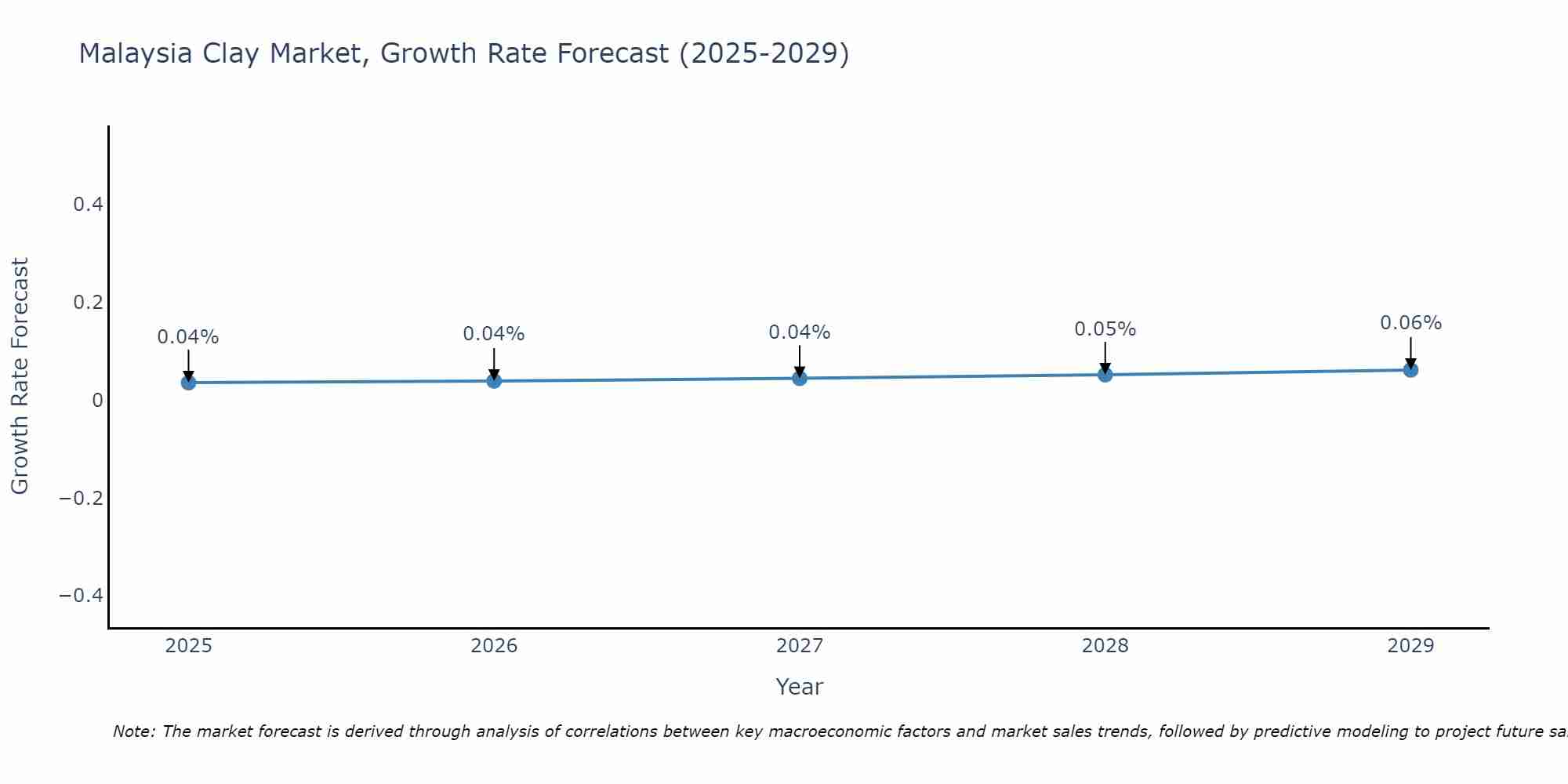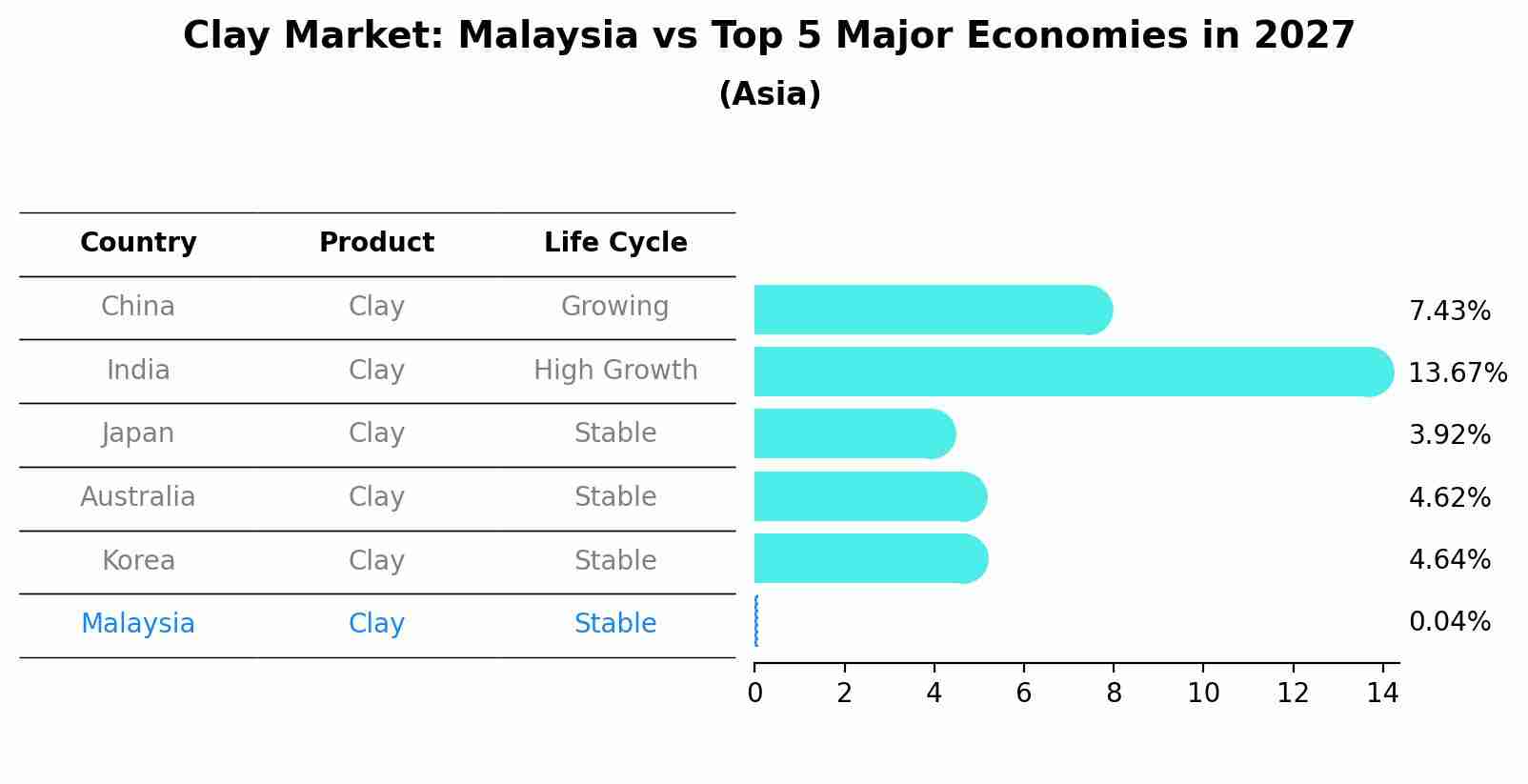Malaysia Clay Market (2025-2031) Outlook | Share, Industry, Analysis, Forecast, Companies, Growth, Size, Revenue, Value & Trends
| Product Code: ETC318986 | Publication Date: Aug 2022 | Updated Date: Aug 2025 | Product Type: Market Research Report | |
| Publisher: 6Wresearch | No. of Pages: 75 | No. of Figures: 35 | No. of Tables: 20 | |
Malaysia Clay Market Size Growth Rate
The Malaysia Clay Market is likely to experience consistent growth rate gains over the period 2025 to 2029. From 0.04% in 2025, the growth rate steadily ascends to 0.06% in 2029.

Clay Market: Malaysia vs Top 5 Major Economies in 2027 (Asia)
The Clay market in Malaysia is projected to grow at a stable growth rate of 0.04% by 2027, highlighting the country's increasing focus on advanced technologies within the Asia region, where China holds the dominant position, followed closely by India, Japan, Australia and South Korea, shaping overall regional demand.

Malaysia Clay Market Synopsis
The clay market in Malaysia serves construction, ceramics, and pottery industries. Market trends may depend on the construction sector`s performance, infrastructure projects, and the demand for clay-based products in various applications.
Drivers of the Market
The clay market in Malaysia is expected to remain robust, driven by the construction and ceramics industries. Clay is a fundamental material in construction, used for manufacturing bricks, tiles, and ceramics. As Malaysia continues to experience urbanization and infrastructure development, the demand for clay products is expected to remain strong. Moreover, the growing interest in sustainable and energy-efficient construction materials may further boost the use of clay-based products in the country.
Challenges of the Market
The Malaysia clay market faces several challenges, including environmental sustainability concerns and competition from alternative materials. Clay mining can have adverse environmental impacts, such as land degradation and water pollution, which can lead to regulatory challenges and increased production costs. Moreover, the market must contend with competition from synthetic materials and alternative natural materials, which can offer cost and performance advantages. Sustainability efforts and exploring new applications for clay can help address these challenges.
COVID 19 Impact on the Market
The clay market in Malaysia has witnessed steady growth over the years, driven by its versatile applications in various industries, including construction, ceramics, and pottery. However, the COVID-19 pandemic had a noticeable impact on the market dynamics. During the initial stages of the pandemic, construction activities were temporarily halted or slowed down, leading to a decrease in the demand for clay products. The manufacturing of ceramics and pottery also faced disruptions due to supply chain interruptions. Despite these challenges, the market showed resilience as construction activities resumed, and the ceramics industry adapted to the changing consumer preferences for home decor and kitchenware products. Moving forward, the Malaysia clay market is expected to gradually recover as economic activities stabilize and the construction sector gains momentum.
Key Players in the Market
Clay is essential for various industries, including ceramics, construction, and pharmaceuticals. In Malaysia, players like Hock Heng Group and Ceramic Materials Supply are major contributors to the clay market. They provide a range of clay products, emphasizing product quality, consistency, and customization to meet diverse industry needs.
Key Highlights of the Report:
- Malaysia Clay Market Outlook
- Market Size of Malaysia Clay Market, 2024
- Forecast of Malaysia Clay Market, 2031
- Historical Data and Forecast of Malaysia Clay Revenues & Volume for the Period 2021-2031
- Malaysia Clay Market Trend Evolution
- Malaysia Clay Market Drivers and Challenges
- Malaysia Clay Price Trends
- Malaysia Clay Porter's Five Forces
- Malaysia Clay Industry Life Cycle
- Historical Data and Forecast of Malaysia Clay Market Revenues & Volume By Application for the Period 2021-2031
- Historical Data and Forecast of Malaysia Clay Market Revenues & Volume By Tableware for the Period 2021-2031
- Historical Data and Forecast of Malaysia Clay Market Revenues & Volume By Sanitary ware for the Period 2021-2031
- Historical Data and Forecast of Malaysia Clay Market Revenues & Volume By Medical applications for the Period 2021-2031
- Historical Data and Forecast of Malaysia Clay Market Revenues & Volume By End Use for the Period 2021-2031
- Historical Data and Forecast of Malaysia Clay Market Revenues & Volume By Ceramic and for the Period 2021-2031
- Historical Data and Forecast of Malaysia Clay Market Revenues & Volume By Non-ceramic for the Period 2021-2031
- Malaysia Clay Import Export Trade Statistics
- Market Opportunity Assessment By Application
- Market Opportunity Assessment By End Use
- Malaysia Clay Top Companies Market Share
- Malaysia Clay Competitive Benchmarking By Technical and Operational Parameters
- Malaysia Clay Company Profiles
- Malaysia Clay Key Strategic Recommendations
Frequently Asked Questions About the Market Study (FAQs):
1 Executive Summary |
2 Introduction |
2.1 Key Highlights of the Report |
2.2 Report Description |
2.3 Market Scope & Segmentation |
2.4 Research Methodology |
2.5 Assumptions |
3 Malaysia Clay Market Overview |
3.1 Malaysia Country Macro Economic Indicators |
3.2 Malaysia Clay Market Revenues & Volume, 2021 & 2031F |
3.3 Malaysia Clay Market - Industry Life Cycle |
3.4 Malaysia Clay Market - Porter's Five Forces |
3.5 Malaysia Clay Market Revenues & Volume Share, By Application, 2021 & 2031F |
3.6 Malaysia Clay Market Revenues & Volume Share, By End Use, 2021 & 2031F |
4 Malaysia Clay Market Dynamics |
4.1 Impact Analysis |
4.2 Market Drivers |
4.2.1 Increasing demand for ceramics and construction industries in Malaysia |
4.2.2 Growing adoption of clay products in the manufacturing sector |
4.2.3 Favorable government initiatives and investments in infrastructure development |
4.3 Market Restraints |
4.3.1 Fluctuating raw material prices impacting production costs |
4.3.2 Competition from alternative materials like plastics and metals |
4.3.3 Environmental regulations and sustainability concerns affecting clay mining and processing |
5 Malaysia Clay Market Trends |
6 Malaysia Clay Market, By Types |
6.1 Malaysia Clay Market, By Application |
6.1.1 Overview and Analysis |
6.1.2 Malaysia Clay Market Revenues & Volume, By Application, 2021-2031F |
6.1.3 Malaysia Clay Market Revenues & Volume, By Tableware, 2021-2031F |
6.1.4 Malaysia Clay Market Revenues & Volume, By Sanitary ware, 2021-2031F |
6.1.5 Malaysia Clay Market Revenues & Volume, By Medical applications, 2021-2031F |
6.2 Malaysia Clay Market, By End Use |
6.2.1 Overview and Analysis |
6.2.2 Malaysia Clay Market Revenues & Volume, By Ceramic and, 2021-2031F |
6.2.3 Malaysia Clay Market Revenues & Volume, By Non-ceramic, 2021-2031F |
7 Malaysia Clay Market Import-Export Trade Statistics |
7.1 Malaysia Clay Market Export to Major Countries |
7.2 Malaysia Clay Market Imports from Major Countries |
8 Malaysia Clay Market Key Performance Indicators |
8.1 Percentage of clay product exports to total production |
8.2 Adoption rate of advanced clay processing technologies |
8.3 Number of new infrastructure projects utilizing clay products |
9 Malaysia Clay Market - Opportunity Assessment |
9.1 Malaysia Clay Market Opportunity Assessment, By Application, 2021 & 2031F |
9.2 Malaysia Clay Market Opportunity Assessment, By End Use, 2021 & 2031F |
10 Malaysia Clay Market - Competitive Landscape |
10.1 Malaysia Clay Market Revenue Share, By Companies, 2024 |
10.2 Malaysia Clay Market Competitive Benchmarking, By Operating and Technical Parameters |
11 Company Profiles |
12 Recommendations |
13 Disclaimer |
- Single User License$ 1,995
- Department License$ 2,400
- Site License$ 3,120
- Global License$ 3,795
Search
Related Reports
- ASEAN and Thailand Brain Health Supplements Market (2025-2031) | Strategy, Consumer Insights, Analysis, Investment Trends, Opportunities, Growth, Size, Share, Industry, Revenue, Segments, Value, Segmentation, Supply, Forecast, Restraints, Outlook, Competition, Drivers, Trends, Demand, Pricing Analysis, Competitive, Strategic Insights, Companies, Challenges
- ASEAN Bearings Market (2025-2031) | Strategy, Consumer Insights, Analysis, Investment Trends, Opportunities, Growth, Size, Share, Industry, Revenue, Segments, Value, Segmentation, Supply, Forecast, Restraints, Outlook, Competition, Drivers, Trends, Demand, Pricing Analysis, Competitive, Strategic Insights, Companies, Challenges
- Europe Flooring Market (2025-2031) | Outlook, Share, Industry, Trends, Forecast, Companies, Revenue, Size, Analysis, Growth & Value
- Saudi Arabia Manlift Market (2025-2031) | Outlook, Size, Growth, Trends, Companies, Industry, Revenue, Value, Share, Forecast & Analysis
- Uganda Excavator, Crane, and Wheel Loaders Market (2025-2031) | Strategy, Consumer Insights, Analysis, Investment Trends, Opportunities, Growth, Size, Share, Industry, Revenue, Segments, Value, Segmentation, Supply, Forecast, Restraints, Outlook, Competition, Drivers, Trends, Demand, Pricing Analysis, Competitive, Strategic Insights, Companies, Challenges
- Rwanda Excavator, Crane, and Wheel Loaders Market (2025-2031) | Strategy, Consumer Insights, Analysis, Investment Trends, Opportunities, Growth, Size, Share, Industry, Revenue, Segments, Value, Segmentation, Supply, Forecast, Restraints, Outlook, Competition, Drivers, Trends, Demand, Pricing Analysis, Competitive, Strategic Insights, Companies, Challenges
- Kenya Excavator, Crane, and Wheel Loaders Market (2025-2031) | Strategy, Consumer Insights, Analysis, Investment Trends, Opportunities, Growth, Size, Share, Industry, Revenue, Segments, Value, Segmentation, Supply, Forecast, Restraints, Outlook, Competition, Drivers, Trends, Demand, Pricing Analysis, Competitive, Strategic Insights, Companies, Challenges
- Angola Excavator, Crane, and Wheel Loaders Market (2025-2031) | Strategy, Consumer Insights, Analysis, Investment Trends, Opportunities, Growth, Size, Share, Industry, Revenue, Segments, Value, Segmentation, Supply, Forecast, Restraints, Outlook, Competition, Drivers, Trends, Demand, Pricing Analysis, Competitive, Strategic Insights, Companies, Challenges
- Israel Intelligent Transport System Market (2025-2031) | Strategy, Consumer Insights, Analysis, Investment Trends, Opportunities, Growth, Size, Share, Industry, Revenue, Segments, Value, Segmentation, Supply, Forecast, Restraints, Outlook, Competition, Drivers, Trends, Demand, Pricing Analysis, Competitive, Strategic Insights, Companies, Challenges
- Uganda Precast and Aggregate Market (2025-2031) | Strategy, Consumer Insights, Analysis, Investment Trends, Opportunities, Growth, Size, Share, Industry, Revenue, Segments, Value, Segmentation, Supply, Forecast, Restraints, Outlook, Competition, Drivers, Trends, Demand, Pricing Analysis, Competitive, Strategic Insights, Companies, Challenges
Industry Events and Analyst Meet
Our Clients
Whitepaper
- Middle East & Africa Commercial Security Market Click here to view more.
- Middle East & Africa Fire Safety Systems & Equipment Market Click here to view more.
- GCC Drone Market Click here to view more.
- Middle East Lighting Fixture Market Click here to view more.
- GCC Physical & Perimeter Security Market Click here to view more.
6WResearch In News
- Doha a strategic location for EV manufacturing hub: IPA Qatar
- Demand for luxury TVs surging in the GCC, says Samsung
- Empowering Growth: The Thriving Journey of Bangladesh’s Cable Industry
- Demand for luxury TVs surging in the GCC, says Samsung
- Video call with a traditional healer? Once unthinkable, it’s now common in South Africa
- Intelligent Buildings To Smooth GCC’s Path To Net Zero













